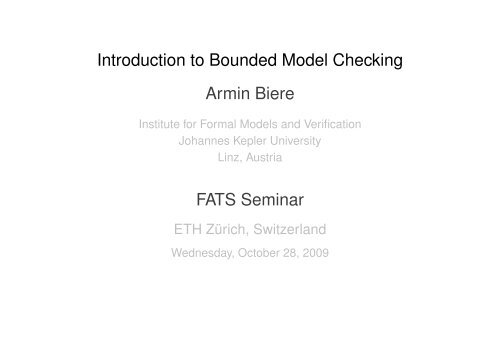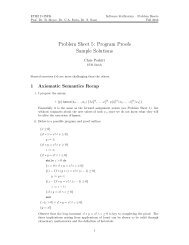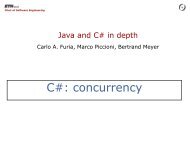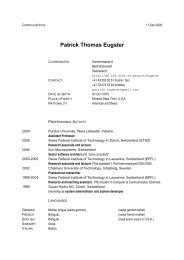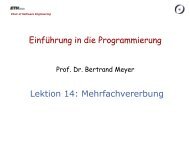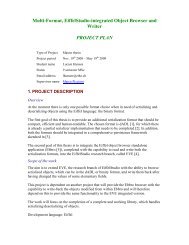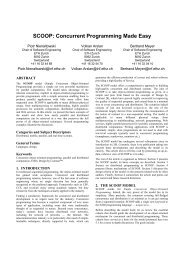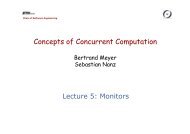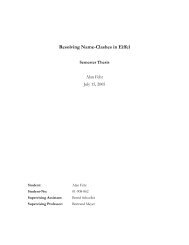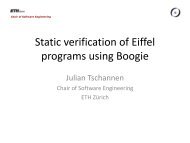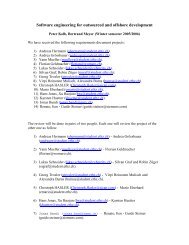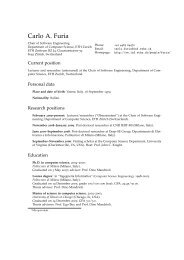Introduction to Bounded Model Checking Armin Biere FATS Seminar
Introduction to Bounded Model Checking Armin Biere FATS Seminar
Introduction to Bounded Model Checking Armin Biere FATS Seminar
Create successful ePaper yourself
Turn your PDF publications into a flip-book with our unique Google optimized e-Paper software.
<strong>Introduction</strong> <strong>to</strong> <strong>Bounded</strong> <strong>Model</strong> <strong>Checking</strong><br />
<strong>Armin</strong> <strong>Biere</strong><br />
Institute for Formal <strong>Model</strong>s and Verification<br />
Johannes Kepler University<br />
Linz, Austria<br />
<strong>FATS</strong> <strong>Seminar</strong><br />
ETH Zürich, Switzerland<br />
Wednesday, Oc<strong>to</strong>ber 28, 2009
A Personal His<strong>to</strong>ry of <strong>Model</strong> <strong>Checking</strong> <strong>Model</strong> <strong>Checking</strong> 1<br />
DavisPutnam’60: DP<br />
DavisLogemannLoveland’62: DPLL<br />
ClarkeEmerson’82: <strong>Model</strong> <strong>Checking</strong><br />
CoudertMadre’89: Symbolic Reachability<br />
Bryant’86: BDDs<br />
Pnueli’77: Temporal Logic<br />
QuielleSifakis’82: <strong>Model</strong> <strong>Checking</strong><br />
BurchClarkeMcMillanDillHwang’90: Symbolic <strong>Model</strong> <strong>Checking</strong><br />
McMillan’93: SMV<br />
Holzmann’91: SPIN<br />
Holzmann’81: On−The−Fly Reachability<br />
Kurshan’93: Localization<br />
Marques−SilvaSakallah’96: GRASP<br />
McMillan’03: Interpolation<br />
<strong>Biere</strong>ArthoSchuppan’01: Liveness2Safety<br />
MoskewiczMadiganZhaoZhangMalik’01: CHAFF<br />
EenSorensson’03: MiniSAT<br />
<strong>Biere</strong>CimattiClarkeZhu’99: <strong>Bounded</strong> <strong>Model</strong> <strong>Checking</strong><br />
SheeranSinghStalmarck’00: k −Induction<br />
BallRajamani’01: SLAM<br />
Peled’94: Partial−Order−Reduction<br />
GrafSaidi’97: Predicate Abstraction<br />
Een<strong>Biere</strong>’05: SatELite<br />
ClarkeEmersonSifakis:<br />
Turing Award 2007<br />
ClarkeGrumbergJahLuVeith’03: CEGAR<br />
<strong>Introduction</strong> <strong>to</strong> <strong>Bounded</strong> <strong>Model</strong> <strong>Checking</strong> – <strong>FATS</strong> <strong>Seminar</strong> ETH 2009 <strong>Armin</strong> <strong>Biere</strong> – FMV – JKU Linz
What is <strong>Model</strong> <strong>Checking</strong>? <strong>Model</strong> <strong>Checking</strong> 2<br />
• mechanically check properties of models<br />
• models:<br />
– finite au<strong>to</strong>mata, labelled transition systems<br />
– often requires au<strong>to</strong>matic/manual abstraction techniques<br />
• properties:<br />
– mostly interested in partial properties<br />
– specified in temporal logic: CTL, LTL, etc.<br />
– safety: something bad should not happen<br />
– liveness: something good should happen<br />
• au<strong>to</strong>matic generation of counterexamples<br />
<strong>Introduction</strong> <strong>to</strong> <strong>Bounded</strong> <strong>Model</strong> <strong>Checking</strong> – <strong>FATS</strong> <strong>Seminar</strong> ETH 2009 <strong>Armin</strong> <strong>Biere</strong> – FMV – JKU Linz
Reachability <strong>Model</strong> <strong>Checking</strong> 3<br />
• set of states S, initial states I, transition relation T<br />
• bad states B reachable from I via T ?<br />
• symbolic representation of T (ciruit, program, parallel product)<br />
– avoid explicit matrix representations, because of the<br />
– state space explosion problem, e.g. n-bit counter: |T | = O(n), |S| = O(2 n )<br />
– makes reachability PSPACE complete [Savitch’70]<br />
• on-the-fly [Holzmann’81’] for pro<strong>to</strong>cols<br />
– restrict search <strong>to</strong> reachable states<br />
– simulate and hash reached concrete states<br />
<strong>Introduction</strong> <strong>to</strong> <strong>Bounded</strong> <strong>Model</strong> <strong>Checking</strong> – <strong>FATS</strong> <strong>Seminar</strong> ETH 2009 <strong>Armin</strong> <strong>Biere</strong> – FMV – JKU Linz
Forward Fixpoint: Initial and Bad States <strong>Model</strong> <strong>Checking</strong> 4<br />
I B<br />
<strong>Introduction</strong> <strong>to</strong> <strong>Bounded</strong> <strong>Model</strong> <strong>Checking</strong> – <strong>FATS</strong> <strong>Seminar</strong> ETH 2009 <strong>Armin</strong> <strong>Biere</strong> – FMV – JKU Linz
Forward Fixpoint: Step 1 <strong>Model</strong> <strong>Checking</strong> 5<br />
I B<br />
<strong>Introduction</strong> <strong>to</strong> <strong>Bounded</strong> <strong>Model</strong> <strong>Checking</strong> – <strong>FATS</strong> <strong>Seminar</strong> ETH 2009 <strong>Armin</strong> <strong>Biere</strong> – FMV – JKU Linz
Forward Fixpoint: Step 2 <strong>Model</strong> <strong>Checking</strong> 6<br />
I B<br />
<strong>Introduction</strong> <strong>to</strong> <strong>Bounded</strong> <strong>Model</strong> <strong>Checking</strong> – <strong>FATS</strong> <strong>Seminar</strong> ETH 2009 <strong>Armin</strong> <strong>Biere</strong> – FMV – JKU Linz
Forward Fixpoint: Step 3 <strong>Model</strong> <strong>Checking</strong> 7<br />
I B<br />
<strong>Introduction</strong> <strong>to</strong> <strong>Bounded</strong> <strong>Model</strong> <strong>Checking</strong> – <strong>FATS</strong> <strong>Seminar</strong> ETH 2009 <strong>Armin</strong> <strong>Biere</strong> – FMV – JKU Linz
Forward Fixpoint: Bad State Reached <strong>Model</strong> <strong>Checking</strong> 8<br />
I B<br />
<strong>Introduction</strong> <strong>to</strong> <strong>Bounded</strong> <strong>Model</strong> <strong>Checking</strong> – <strong>FATS</strong> <strong>Seminar</strong> ETH 2009 <strong>Armin</strong> <strong>Biere</strong> – FMV – JKU Linz
Forward Fixpoint: Termination, No Bad State Reachable <strong>Model</strong> <strong>Checking</strong> 9<br />
I B<br />
<strong>Introduction</strong> <strong>to</strong> <strong>Bounded</strong> <strong>Model</strong> <strong>Checking</strong> – <strong>FATS</strong> <strong>Seminar</strong> ETH 2009 <strong>Armin</strong> <strong>Biere</strong> – FMV – JKU Linz
Forward Least Fixpoint Algorithm for <strong>Model</strong> <strong>Checking</strong> Safety <strong>Model</strong> <strong>Checking</strong> 10<br />
initial states I, transition relation T , bad states B<br />
model-check µ<br />
forward<br />
S C = /0; SN = I;<br />
while S C = SN do<br />
if B ∩ SN = /0 then<br />
(I, T, B)<br />
return “found error trace <strong>to</strong> bad states”;<br />
S C = SN;<br />
SN = S C ∪ Img(S C) ;<br />
done;<br />
return “no bad state reachable”;<br />
<strong>Introduction</strong> <strong>to</strong> <strong>Bounded</strong> <strong>Model</strong> <strong>Checking</strong> – <strong>FATS</strong> <strong>Seminar</strong> ETH 2009 <strong>Armin</strong> <strong>Biere</strong> – FMV – JKU Linz
Symbolic <strong>Model</strong> <strong>Checking</strong> <strong>Model</strong> <strong>Checking</strong> 11<br />
• work with symbolic representations of states<br />
– symbolic representations are potentially exponentially more succinct<br />
– favors BFS: next frontier set of states in BFS is calculated symbolically<br />
• originally “symbolic” meant model checking with BDDs<br />
[CoudertMadre’89/’90,BurchClarkeMcMillanDillHwang’90,McMillan’93]<br />
• Binary Decision Diagrams [Bryant’86]<br />
– canonical representation for boolean functions<br />
– BDDs have fast operations (but image computation is expensive)<br />
– often blow up in space<br />
– restricted <strong>to</strong> hundreds of variables<br />
<strong>Introduction</strong> <strong>to</strong> <strong>Bounded</strong> <strong>Model</strong> <strong>Checking</strong> – <strong>FATS</strong> <strong>Seminar</strong> ETH 2009 <strong>Armin</strong> <strong>Biere</strong> – FMV – JKU Linz
Linear Size BDD for Bit-Vec<strong>to</strong>r Comparison <strong>Model</strong> <strong>Checking</strong> 12<br />
0<br />
0<br />
0<br />
x<br />
x 2<br />
2 2<br />
x<br />
x<br />
3<br />
y y<br />
3 3<br />
y y<br />
1<br />
y y<br />
1 1<br />
0<br />
y y<br />
0 0<br />
0 1<br />
0<br />
0<br />
0<br />
0<br />
boolean function/expression:<br />
n−1<br />
^<br />
i=0<br />
xi = yi<br />
interleaved variable order:<br />
x3 > y3 > x2 > y2 > x1 > y1 > x0 > y0<br />
comparison of two n-bit-vec<strong>to</strong>rs needs 3·n inner<br />
nodes for the interleaved variable order<br />
<strong>Introduction</strong> <strong>to</strong> <strong>Bounded</strong> <strong>Model</strong> <strong>Checking</strong> – <strong>FATS</strong> <strong>Seminar</strong> ETH 2009 <strong>Armin</strong> <strong>Biere</strong> – FMV – JKU Linz
Exponential BDD for Bit-Vec<strong>to</strong>r Comparison <strong>Model</strong> <strong>Checking</strong> 13<br />
y 3<br />
missing edges<br />
lead <strong>to</strong> 0<br />
x 0<br />
x1<br />
x 0<br />
x 2<br />
x 0<br />
x1<br />
x 0<br />
y3 y3 y3 y3 y3 y3 y3 y3 y3 y3 y3 y3 y 2 y 2 y 2 y 2<br />
y 1<br />
y 0<br />
x 3<br />
1<br />
x 0<br />
x1<br />
x 0<br />
x 2<br />
x 0<br />
y 3<br />
x1<br />
y 3<br />
x 0<br />
y 2 y 2 y 2 y 2<br />
y 1 y 1 y 1<br />
<strong>Introduction</strong> <strong>to</strong> <strong>Bounded</strong> <strong>Model</strong> <strong>Checking</strong> – <strong>FATS</strong> <strong>Seminar</strong> ETH 2009 <strong>Armin</strong> <strong>Biere</strong> – FMV – JKU Linz<br />
y 0<br />
y 3
Unrolling of Forward Least Fixpoint Algorithm <strong>Model</strong> <strong>Checking</strong> 14<br />
0: continue? S 0 C = S0 N ∃s0[I(s0)]<br />
0: terminate? S 0 C = S0 N ∀s0[¬I(s0)]<br />
0: bad state? B ∩ S 0 N = /0 ∃s0[I(s0) ∧ B(s0)]<br />
1: continue? S 1 C = S1 N ∃s0,s1[I(s0) ∧ T (s0,s1) ∧ ¬I(s1)]<br />
1: terminate? S 1 C = S1 N ∀s0,s1[I(s0) ∧ T (s0,s1) → I(s1)]<br />
1: bad state? B ∩ S 1 N = /0 ∃s0,s1[I(s0) ∧ T (s0,s1) ∧ B(s1)]<br />
2: continue? S 2 C = S2 N ∃s0,s1,s2[I(s0) ∧ T (s0,s1) ∧ T (s1,s2) ∧<br />
¬(I(s2) ∨ ∃t0[I(t0) ∧ T (t0,s2)])]<br />
2: terminate? S 2 C = S2 N ∀s0,s1,s2[I(s0) ∧ T (s0,s1) ∧ T (s1,s2) →<br />
I(s2) ∨ ∃t0[I(t0) ∧ T (t0,s2)]]<br />
2: bad state? B ∩ S 1 N = /0 ∃s0,s1,s2[I(s0) ∧ T (s0,s1) ∧ T (s1,s2) ∧ B(s2)]<br />
<strong>Introduction</strong> <strong>to</strong> <strong>Bounded</strong> <strong>Model</strong> <strong>Checking</strong> – <strong>FATS</strong> <strong>Seminar</strong> ETH 2009 <strong>Armin</strong> <strong>Biere</strong> – FMV – JKU Linz
Falsification Part of Fixpoint Algorithm <strong>Model</strong> <strong>Checking</strong><br />
[<strong>Biere</strong>CimattiClarkeZhu-TACAS’99] 15<br />
0: continue? S 0 C = S0 N ∃s0[I(s0)]<br />
0: terminate? S 0 C = S0 N ∀s0[¬I(s0)]<br />
0: bad state? B ∩ S 0 N = /0 ∃s0[I(s0) ∧ B(s0)]<br />
1: continue? S 1 C = S1 N ∃s0,s1[I(s0) ∧ T (s0,s1) ∧ ¬I(s1)]<br />
1: terminate? S 1 C = S1 N ∀s0,s1[I(s0) ∧ T (s0,s1) → I(s1)]<br />
1: bad state? B ∩ S 1 N = /0 ∃s0,s1[I(s0) ∧ T (s0,s1) ∧ B(s1)]<br />
2: continue? S 2 C = S2 N ∃s0,s1,s2[I(s0) ∧ T (s0,s1) ∧ T (s1,s2) ∧<br />
¬(I(s2) ∨ ∃t0[I(t0) ∧ T (t0,s2)])]<br />
2: terminate? S 2 C = S2 N ∀s0,s1,s2[I(s0) ∧ T (s0,s1) ∧ T (s1,s2) →<br />
I(s2) ∨ ∃t0[I(t0) ∧ T (t0,s2)]]<br />
2: bad state? B ∩ S 1 N = /0 ∃s0,s1,s2[I(s0) ∧ T (s0,s1) ∧ T (s1,s2) ∧ B(s2)]<br />
<strong>Introduction</strong> <strong>to</strong> <strong>Bounded</strong> <strong>Model</strong> <strong>Checking</strong> – <strong>FATS</strong> <strong>Seminar</strong> ETH 2009 <strong>Armin</strong> <strong>Biere</strong> – FMV – JKU Linz
<strong>Bounded</strong> <strong>Model</strong> <strong>Checking</strong> BMC<br />
[<strong>Biere</strong>CimattiClarkeZhu-TACAS’99] 16<br />
• look only for counter example made of k states (the bound)<br />
s0 s1 sl sl+1 sk B<br />
B<br />
B<br />
B<br />
• simple for safety properties: bad state B is reachable<br />
BMC(k) : I(s0) ∧ T (s0,s1) ∧ ··· ∧ T (s k−1,s k) ∧<br />
B<br />
or<br />
s0 s1 sl sl+1 sk N<br />
N<br />
k_<br />
i=0<br />
N<br />
B(si)<br />
• harder for liveness properties cycle with no progress states N reachable<br />
I(s0) ∧ T (s0,s1) ∧ ··· ∧ T (s k−1,s k) ∧<br />
k^<br />
i=0<br />
N(si) ∧ ∃l T (s k,s l)<br />
• can also encode liveness in<strong>to</strong> safety [<strong>Biere</strong>ArthoSchuppan’01]<br />
<strong>Introduction</strong> <strong>to</strong> <strong>Bounded</strong> <strong>Model</strong> <strong>Checking</strong> – <strong>FATS</strong> <strong>Seminar</strong> ETH 2009 <strong>Armin</strong> <strong>Biere</strong> – FMV – JKU Linz<br />
N<br />
N
<strong>Bounded</strong> <strong>Model</strong> <strong>Checking</strong> BMC<br />
[<strong>Biere</strong>CimattiClarkeZhu-TACAS’99] 17<br />
• look only for counter example made of k states (the bound)<br />
s0 s1 sl sl+1 sk B<br />
B<br />
B<br />
B<br />
• simple for safety properties: bad state B is reachable<br />
BMC(k) : I(s0) ∧ T (s0,s1) ∧ ··· ∧ T (s k−1,s k) ∧<br />
B<br />
or<br />
s0 s1 sl sl+1 sk N<br />
N<br />
k_<br />
i=0<br />
N<br />
B(si)<br />
• harder for liveness properties cycle with no progress states N reachable<br />
I(s0) ∧ T (s0,s1) ∧ ··· ∧ T (s k−1,s k) ∧<br />
k^<br />
i=0<br />
N(si) ∧<br />
• can also encode liveness in<strong>to</strong> safety [<strong>Biere</strong>ArthoSchuppan’01]<br />
k_<br />
l=0<br />
N<br />
T (s k,s l)<br />
<strong>Introduction</strong> <strong>to</strong> <strong>Bounded</strong> <strong>Model</strong> <strong>Checking</strong> – <strong>FATS</strong> <strong>Seminar</strong> ETH 2009 <strong>Armin</strong> <strong>Biere</strong> – FMV – JKU Linz<br />
N
<strong>Bounded</strong> <strong>Model</strong> <strong>Checking</strong> State of the Art BMC<br />
see also Chapter 14 on BMC in Handbook of Satisfiability 18<br />
• increase in efficiency of SAT solvers [Grasp,zChaff,MiniSAT,SatELite,...]<br />
• SAT more robust than BDDs in bug finding<br />
(shallow bugs are easily reached by explicit model checking or testing)<br />
• better unbounded but still SAT based model checking algorithms<br />
– k-induction [SinghSheeranStalmarck’00]<br />
– interpolation [McMillan’03]<br />
• 4th Intl. Workshop on <strong>Bounded</strong> <strong>Model</strong> <strong>Checking</strong> (BMC’06)<br />
• other logics, better encodings, e.g. [Latvala<strong>Biere</strong>HeljankoJuntilla-FMCAD’04]<br />
• other models, e.g. C/C++/Verilog [Kröning...], hybrid au<strong>to</strong>mata [Audemard...-BMC’04]<br />
<strong>Introduction</strong> <strong>to</strong> <strong>Bounded</strong> <strong>Model</strong> <strong>Checking</strong> – <strong>FATS</strong> <strong>Seminar</strong> ETH 2009 <strong>Armin</strong> <strong>Biere</strong> – FMV – JKU Linz
Induction with SAT BMC 19<br />
[SinghSheeranStalmarck’00]<br />
• more specifically k-induction<br />
– does there exist k such that the following formula is unsatisfiable<br />
B(s0) ∧ ··· ∧ B(sk−1) ∧ T (s0,s1) ∧ ··· ∧ T (sk−1,sk) ∧ B(sk) ∧ ^<br />
0≤i< j≤k<br />
– if unsatisfiable and BMC(k) unsatisfiable then bad state unreachable<br />
• bound on k: length of longest cycle free path = reoccurrence diameter<br />
• k = 0 check whether ¬B tau<strong>to</strong>logical (propositionally)<br />
• k = 1 check whether ¬B inductive for T<br />
si = s j<br />
<strong>Introduction</strong> <strong>to</strong> <strong>Bounded</strong> <strong>Model</strong> <strong>Checking</strong> – <strong>FATS</strong> <strong>Seminar</strong> ETH 2009 <strong>Armin</strong> <strong>Biere</strong> – FMV – JKU Linz
Interpolation in <strong>Model</strong> <strong>Checking</strong> BMC 20<br />
[McMillan’03]<br />
• SAT based technique <strong>to</strong> overapproximate frontiers Img(S C)<br />
– currently most effective technique <strong>to</strong> show that bad states are unreachable<br />
– better than BDDs and k-induction in many cases [HWMCC’08]<br />
• starts from a resolution proof refutation of a BMC problem with bound k + 1<br />
S C(s0) ∧ T (s0,s1) ∧ T (s1,s2) ∧ ··· ∧ T (s k,s k+1) ∧ B(s k+1)<br />
– result is a characteristic function f (s1) over variables of the second state s1<br />
– these states do not reach the bad state s k+1 in k steps<br />
– any state reachable from S C satisfies f : S C(s0) ∧ T (s0,s1) ⇒ f (s1)<br />
• k is bounded by the diameter (exponentially smaller than longest cycle free path)<br />
<strong>Introduction</strong> <strong>to</strong> <strong>Bounded</strong> <strong>Model</strong> <strong>Checking</strong> – <strong>FATS</strong> <strong>Seminar</strong> ETH 2009 <strong>Armin</strong> <strong>Biere</strong> – FMV – JKU Linz
Generating Propositional Interpolants from Resolution BMC<br />
Chapter 14 on BMC in Handbook of Satisfiability 21<br />
A ∧ B unsatisfiable then f is an interpolant iff<br />
(I1) A ⇒ f and (I2) B ∧ f ⇒ ⊥<br />
an interpolating quadruple (A,B) c [ f ] is well formed if<br />
(W1) V (c) ⊆ V (A) ∪V (B) and (W2) V ( f ) ⊆ G ∪V (c) with G = V (A) ∩V (B)<br />
an interpolating quadruple (A,B) c [ f ] is valid if<br />
(V1) A ⇒ f and (V2) B ∧ f ⇒ c<br />
proof rules which produce well formed and valid interpolating quadruples:<br />
(R1)<br />
(R2)<br />
(A,B) c [c]<br />
(A,B) c [⊤]<br />
c ∈ A<br />
c ∈ B<br />
(A,B) c . ∨ l [ f ] (A,B) d . ∨ l [g]<br />
(A,B) c ∨ d [ f ∧ g]<br />
(A,B) c . ∨ l [ f ] (A,B) d . ∨ l [g]<br />
(A,B) c ∨ d [ f | l ∨ g| l ]<br />
|l| ∈ V (B)<br />
|l| ∈ V (B)<br />
<strong>Introduction</strong> <strong>to</strong> <strong>Bounded</strong> <strong>Model</strong> <strong>Checking</strong> – <strong>FATS</strong> <strong>Seminar</strong> ETH 2009 <strong>Armin</strong> <strong>Biere</strong> – FMV – JKU Linz<br />
(R3)<br />
(R4)
Mining Inductive Invariants BMC 22<br />
• through abstract interpretation resp. static analysis, or alternatively ...<br />
• randomly simulate model and extract potential invariants<br />
– signals / predicates which always hold<br />
– implications of signals / predicates that occur in the simulation / tests<br />
– equivalent signals (works well in sequential equivalence checking)<br />
• prove them <strong>to</strong> be k-inductive<br />
– quite natural in sequential equivalence checking for circuits<br />
– synthesis algorithms also only see finitely many time steps<br />
• how <strong>to</strong> obtain environment model / constraints / contracts?<br />
<strong>Introduction</strong> <strong>to</strong> <strong>Bounded</strong> <strong>Model</strong> <strong>Checking</strong> – <strong>FATS</strong> <strong>Seminar</strong> ETH 2009 <strong>Armin</strong> <strong>Biere</strong> – FMV – JKU Linz
Using Inductive Invariants BMC 23<br />
• inductive invariants help <strong>to</strong> speed-up both k-induction (and interpolation)<br />
• let P be inductive: I(s) ⇒ P(s) and T (s,s ′ ) ∧ P(s) ⇒ P(s ′ )<br />
• we want <strong>to</strong> prove that a bad state can not reached<br />
• if BMC(k) is unsatisfiable it is enough <strong>to</strong> prove unsatisfiability of<br />
P(s0) ∧<br />
P(s1) ∧ ··· ∧ P(s k) ∧<br />
B(s0) ∧ ··· ∧ B(s k−1) ∧<br />
T (s0,s1) ∧ ··· ∧ T (s k−1,s k) ∧ B(s k) ∧ V<br />
0≤i< j≤k<br />
si = s j<br />
• this formula can become unsatisfiable much earlier, i.e. for smaller k, than<br />
B(s0) ∧ ··· ∧ B(s k−1) ∧<br />
T (s0,s1) ∧ ··· ∧ T (s k−1,s k) ∧ B(s k) ∧ V<br />
0≤i< j≤k<br />
si = s j<br />
<strong>Introduction</strong> <strong>to</strong> <strong>Bounded</strong> <strong>Model</strong> <strong>Checking</strong> – <strong>FATS</strong> <strong>Seminar</strong> ETH 2009 <strong>Armin</strong> <strong>Biere</strong> – FMV – JKU Linz
Simple Path Constraints Symbolic All-Different Constraints<br />
[<strong>Biere</strong>Brummayer-FMCAD’08] 24<br />
• bounded model checking: [<strong>Biere</strong>CimattiClarkeZhu’99]<br />
I(s1) ∧ T (s1,s2) ∧ ... ∧ T (sk−1,sk) ∧ _<br />
B(si) satisfiable?<br />
0≤i≤k<br />
• reoccurrence diameter checking: [<strong>Biere</strong>CimattiClarkeZhu’99]<br />
T (s1,s2) ∧ ... ∧ T (sk−1,sk) ∧ ^<br />
si = s j unsatisfiable?<br />
1≤i< j≤k<br />
• k-induction base case: [SheeranSinghSt˚almarck’00]<br />
I(s1) ∧ T (s1,s2) ∧ ... ∧ T (sk−1,sk) ∧ B(sk) ∧ ^<br />
¬B(si) satisfiable?<br />
0≤i
All Different Constraints (ADC) Symbolic All-Different Constraints<br />
[<strong>Biere</strong>Brummayer-FMCAD’08] 25<br />
• classical concept in constraint programming:<br />
– k variables over a domain of size m supposed <strong>to</strong> have different values<br />
– for instance k-queen problem<br />
• propagation algorithms <strong>to</strong> establish arc-consistency<br />
– explicit propaga<strong>to</strong>rs: [Régin’94]<br />
∗ O(k · m) space<br />
∗ O(k 2 · m 2 ) time<br />
– symbolic propaga<strong>to</strong>rs: [GentNightingale’04] also [MarquesSilvaLynce’07]<br />
∗ one-hot CNF encoding with Ω(k · m) boolean variables<br />
• in model checking k 2 100 n latches<br />
<strong>Introduction</strong> <strong>to</strong> <strong>Bounded</strong> <strong>Model</strong> <strong>Checking</strong> – <strong>FATS</strong> <strong>Seminar</strong> ETH 2009 <strong>Armin</strong> <strong>Biere</strong> – FMV – JKU Linz
Symbolic ADCs for Large Domains Symbolic All-Different Constraints<br />
[<strong>Biere</strong>Brummayer-FMCAD’08] 26<br />
• encoding bit-vec<strong>to</strong>r inequalities directly:<br />
– let u, v be two n-bit vec<strong>to</strong>rs, d0,...,dn−1 fresh boolean variables<br />
u = v is equisatisfiable <strong>to</strong> (d0 ∨ ··· ∨ dn−1) ∧<br />
n−1 ^<br />
j=0<br />
(u j ∨ v j ∨ d j) ∧ (u j ∨ v j ∨ d j)<br />
– can be extended <strong>to</strong> encode Ackermann Constraints + McCarthy Axioms<br />
– either eagerly encode all si = s j quadratic in k<br />
– or refine adding bit-vec<strong>to</strong>r inequalities on demand [EénSörensson-BMC’03]<br />
• natively handle ADCs within SAT solver: main contribution in FMCAD’08<br />
– similar <strong>to</strong> theory consistency checking in lazy SMT vs. “lemmas on demand”<br />
– can be extended <strong>to</strong> also perform theory propagation<br />
• sorting networks ineffective in our experience [KröningStrichman’03,Jussila<strong>Biere</strong>’06]<br />
<strong>Introduction</strong> <strong>to</strong> <strong>Bounded</strong> <strong>Model</strong> <strong>Checking</strong> – <strong>FATS</strong> <strong>Seminar</strong> ETH 2009 <strong>Armin</strong> <strong>Biere</strong> – FMV – JKU Linz
Lemmas on Demand for ADCs Symbolic All-Different Constraints<br />
TIP [EénSörensson-BMC’03] 27<br />
Abstract<br />
just leave out ADCs<br />
do not encode them<br />
call SAT solver<br />
incrementally<br />
SAT?<br />
NO<br />
YES<br />
add violated ADC(s) as<br />
Lemma on Demand<br />
Refine<br />
YES<br />
Spurious?<br />
NO<br />
check solution:<br />
violates any<br />
original ADC?<br />
<strong>Introduction</strong> <strong>to</strong> <strong>Bounded</strong> <strong>Model</strong> <strong>Checking</strong> – <strong>FATS</strong> <strong>Seminar</strong> ETH 2009 <strong>Armin</strong> <strong>Biere</strong> – FMV – JKU Linz
Lemmas on Demand for Satisfiability Modulo Theory (SMT)<br />
[DeMouraRueß-SAT’02] [BarrettDillStump-CAV’02] ... 28<br />
Abstract<br />
only keep boolean<br />
skele<strong>to</strong>n of original<br />
first−order formula<br />
call SAT solver<br />
incrementally<br />
SAT?<br />
NO<br />
add instance of violated axiom as<br />
lemma on demand<br />
YES<br />
Refine<br />
YES<br />
Spurious?<br />
NO<br />
check solution:<br />
violates any<br />
theory axiom<br />
<strong>Introduction</strong> <strong>to</strong> <strong>Bounded</strong> <strong>Model</strong> <strong>Checking</strong> – <strong>FATS</strong> <strong>Seminar</strong> ETH 2009 <strong>Armin</strong> <strong>Biere</strong> – FMV – JKU Linz
Localization / Counter Example Guided Abstraction Refinement 29<br />
Localization [Kurshan’93], Predicate Abstraction [GrafSaidi’97],<br />
SLAM [BallRajamani’01], CEGAR [ClarkeGrumbergJhaLuVeith’03]<br />
Abstract<br />
cut connections in model<br />
locally around property<br />
call model checker<br />
incrementally<br />
SAT?<br />
NO<br />
add more logic of model as<br />
lemma on demand<br />
YES<br />
Refine<br />
YES<br />
Spurious?<br />
NO<br />
check solution:<br />
impossible <strong>to</strong><br />
extend<br />
<strong>to</strong> full model<br />
<strong>Introduction</strong> <strong>to</strong> <strong>Bounded</strong> <strong>Model</strong> <strong>Checking</strong> – <strong>FATS</strong> <strong>Seminar</strong> ETH 2009 <strong>Armin</strong> <strong>Biere</strong> – FMV – JKU Linz
Lemmas on Demand for Extensional Arrays Boolec<strong>to</strong>r: Bit-Vec<strong>to</strong>r and Arrays<br />
[Brummayer<strong>Biere</strong>-JSAT’09] 30<br />
Abstract<br />
replace array reads<br />
and equality checks<br />
by fresh variables<br />
call SAT solver<br />
incrementally<br />
SAT?<br />
NO<br />
add instance of violated axiom as<br />
lemma on demand<br />
YES<br />
Refine<br />
YES<br />
Spurious?<br />
NO<br />
check solution:<br />
violates any<br />
array axiom<br />
<strong>Introduction</strong> <strong>to</strong> <strong>Bounded</strong> <strong>Model</strong> <strong>Checking</strong> – <strong>FATS</strong> <strong>Seminar</strong> ETH 2009 <strong>Armin</strong> <strong>Biere</strong> – FMV – JKU Linz
Early Unsat Termination Boolec<strong>to</strong>r: Bit-Vec<strong>to</strong>r and Arrays<br />
[Brummayer<strong>Biere</strong>-EuroCAST’09] 31<br />
Encode input <strong>to</strong> CNF<br />
Add under−approx. clauses C<br />
SAT?<br />
Call SAT solver<br />
YES<br />
NO YES<br />
C used?<br />
Formula is satisfiable Formula is unsatisfiable<br />
Refine under−approx.<br />
<strong>Introduction</strong> <strong>to</strong> <strong>Bounded</strong> <strong>Model</strong> <strong>Checking</strong> – <strong>FATS</strong> <strong>Seminar</strong> ETH 2009 <strong>Armin</strong> <strong>Biere</strong> – FMV – JKU Linz<br />
NO
Combining Over- and Under-Approximation Boolec<strong>to</strong>r: Bit-Vec<strong>to</strong>r and Arrays<br />
[Brummayer<strong>Biere</strong>-EuroCAST’09] 32<br />
Array formula<br />
Formula is satisfiable<br />
NO<br />
spurious?<br />
YES<br />
YES<br />
Call SAT solver<br />
Refine over−approx.<br />
Add under−approx. clauses C<br />
SAT?<br />
Add lemma<br />
Over−approximate<br />
Call SAT solver<br />
Encode <strong>to</strong> CNF<br />
NO YES<br />
C used?<br />
Formula is unsatisfiable<br />
Refine under−approx.<br />
<strong>Introduction</strong> <strong>to</strong> <strong>Bounded</strong> <strong>Model</strong> <strong>Checking</strong> – <strong>FATS</strong> <strong>Seminar</strong> ETH 2009 <strong>Armin</strong> <strong>Biere</strong> – FMV – JKU Linz<br />
NO
Lazy SMT Boolec<strong>to</strong>r: Bit-Vec<strong>to</strong>r and Arrays<br />
survey on lazy SMT [Sebastiani-JSAT’07] 33<br />
• Lemmas on Demand are as lazy as it gets<br />
– SAT solver enumerates full models of propositional skele<strong>to</strong>n<br />
– abstracted lemmas are added / learned on demand<br />
– theory solver checks consistency of conjunction of theory literals<br />
• on-the-fly consistency checking<br />
– additionally theory solver checks consistency of partial model as well<br />
• theory propagation<br />
– theory solver even deduces and notifies SAT solver about implied values of literals<br />
• generic framework: DPLL(T) [NieuwenhuisOliverasTinelli-JACM’06]<br />
<strong>Introduction</strong> <strong>to</strong> <strong>Bounded</strong> <strong>Model</strong> <strong>Checking</strong> – <strong>FATS</strong> <strong>Seminar</strong> ETH 2009 <strong>Armin</strong> <strong>Biere</strong> – FMV – JKU Linz
All Different Objects (ADOs) Symbolic All-Different Constraints<br />
[<strong>Biere</strong>Brummayer-FMCAD’08] 34<br />
hash<br />
u 2 u 1<br />
u 0<br />
watch<br />
ADO for u<br />
v 2 v 1 v 0 ADO for v<br />
w 2 w 1 w 0 ADO for w<br />
<strong>Introduction</strong> <strong>to</strong> <strong>Bounded</strong> <strong>Model</strong> <strong>Checking</strong> – <strong>FATS</strong> <strong>Seminar</strong> ETH 2009 <strong>Armin</strong> <strong>Biere</strong> – FMV – JKU Linz
All Different Objects (ADOs) Symbolic All-Different Constraints<br />
[<strong>Biere</strong>Brummayer-FMCAD’08] 35<br />
hash<br />
0<br />
assign<br />
u 1<br />
u 0<br />
ADO for u<br />
v 2 v 1 v 0 ADO for v<br />
w 2 w 1 w 0 ADO for w<br />
<strong>Introduction</strong> <strong>to</strong> <strong>Bounded</strong> <strong>Model</strong> <strong>Checking</strong> – <strong>FATS</strong> <strong>Seminar</strong> ETH 2009 <strong>Armin</strong> <strong>Biere</strong> – FMV – JKU Linz
All Different Objects (ADOs) Symbolic All-Different Constraints<br />
[<strong>Biere</strong>Brummayer-FMCAD’08] 36<br />
hash<br />
0<br />
u 1<br />
1<br />
ADO for u<br />
v 2 v 1 v 0 ADO for v<br />
w 2 w 1 w 0 ADO for w<br />
<strong>Introduction</strong> <strong>to</strong> <strong>Bounded</strong> <strong>Model</strong> <strong>Checking</strong> – <strong>FATS</strong> <strong>Seminar</strong> ETH 2009 <strong>Armin</strong> <strong>Biere</strong> – FMV – JKU Linz
All Different Objects (ADOs) Symbolic All-Different Constraints<br />
[<strong>Biere</strong>Brummayer-FMCAD’08] 37<br />
hash<br />
0 u 1 1<br />
move<br />
ADO for u<br />
v 2 v 1 v 0 ADO for v<br />
w 2 w 1 w 0 ADO for w<br />
<strong>Introduction</strong> <strong>to</strong> <strong>Bounded</strong> <strong>Model</strong> <strong>Checking</strong> – <strong>FATS</strong> <strong>Seminar</strong> ETH 2009 <strong>Armin</strong> <strong>Biere</strong> – FMV – JKU Linz
All Different Objects (ADOs) Symbolic All-Different Constraints<br />
[<strong>Biere</strong>Brummayer-FMCAD’08] 38<br />
hash<br />
0 u 1 1<br />
0<br />
1<br />
v 0<br />
ADO for u<br />
ADO for v<br />
w 2 w 1 w 0 ADO for w<br />
<strong>Introduction</strong> <strong>to</strong> <strong>Bounded</strong> <strong>Model</strong> <strong>Checking</strong> – <strong>FATS</strong> <strong>Seminar</strong> ETH 2009 <strong>Armin</strong> <strong>Biere</strong> – FMV – JKU Linz
All Different Objects (ADOs) Symbolic All-Different Constraints<br />
[<strong>Biere</strong>Brummayer-FMCAD’08] 39<br />
hash<br />
0 u 1 1<br />
0 1<br />
w 2<br />
1<br />
v 0<br />
1<br />
ADO for u<br />
ADO for v<br />
ADO for w<br />
<strong>Introduction</strong> <strong>to</strong> <strong>Bounded</strong> <strong>Model</strong> <strong>Checking</strong> – <strong>FATS</strong> <strong>Seminar</strong> ETH 2009 <strong>Armin</strong> <strong>Biere</strong> – FMV – JKU Linz
All Different Objects (ADOs) Symbolic All-Different Constraints<br />
[<strong>Biere</strong>Brummayer-FMCAD’08] 40<br />
hash<br />
0 1 1<br />
0 1<br />
w 2<br />
v 0<br />
1 1<br />
complete<br />
ADO for u<br />
ADO for v<br />
ADO for w<br />
<strong>Introduction</strong> <strong>to</strong> <strong>Bounded</strong> <strong>Model</strong> <strong>Checking</strong> – <strong>FATS</strong> <strong>Seminar</strong> ETH 2009 <strong>Armin</strong> <strong>Biere</strong> – FMV – JKU Linz
All Different Objects (ADOs) Symbolic All-Different Constraints<br />
[<strong>Biere</strong>Brummayer-FMCAD’08] 41<br />
hash<br />
insert<br />
0 1 1<br />
0 1<br />
w 2<br />
v 0<br />
1 1<br />
ADO for u<br />
ADO for v<br />
ADO for w<br />
<strong>Introduction</strong> <strong>to</strong> <strong>Bounded</strong> <strong>Model</strong> <strong>Checking</strong> – <strong>FATS</strong> <strong>Seminar</strong> ETH 2009 <strong>Armin</strong> <strong>Biere</strong> – FMV – JKU Linz
All Different Objects (ADOs) Symbolic All-Different Constraints<br />
[<strong>Biere</strong>Brummayer-FMCAD’08] 42<br />
hash<br />
0 1 1<br />
lookup<br />
0 1<br />
w 2<br />
1<br />
1 1<br />
ADO for u<br />
ADO for v<br />
ADO for w<br />
<strong>Introduction</strong> <strong>to</strong> <strong>Bounded</strong> <strong>Model</strong> <strong>Checking</strong> – <strong>FATS</strong> <strong>Seminar</strong> ETH 2009 <strong>Armin</strong> <strong>Biere</strong> – FMV – JKU Linz
All Different Objects (ADOs) Symbolic All-Different Constraints<br />
[<strong>Biere</strong>Brummayer-FMCAD’08] 43<br />
hash<br />
0 1 1<br />
0 1<br />
w 2<br />
1<br />
1 1<br />
ADO for u<br />
conflict<br />
u = v<br />
ADO for v<br />
ADO for w<br />
<strong>Introduction</strong> <strong>to</strong> <strong>Bounded</strong> <strong>Model</strong> <strong>Checking</strong> – <strong>FATS</strong> <strong>Seminar</strong> ETH 2009 <strong>Armin</strong> <strong>Biere</strong> – FMV – JKU Linz
Implementation Details Symbolic All-Different Constraints<br />
[<strong>Biere</strong>Brummayer-FMCAD’08] 44<br />
• ADO key is calculated from concrete bit-vec<strong>to</strong>r<br />
– by for instance XOR’ing bits word by word<br />
• ADOs watched by variables (not literals)<br />
– during backtracking all inserted ADOs need <strong>to</strong> be removed from hash table<br />
– save whether variable assignment forced ADO <strong>to</strong> be inserted<br />
– stack like insert/remove operations on hash table allow open addressing<br />
• conflict analysis<br />
– all bits of the bit-vec<strong>to</strong>rs in conflict are followed<br />
– can be implemented by temporarily generating a pseudo clause<br />
(u2 ∨ u1 ∨ u0 ∨ v2 ∨ v1 ∨ v0)<br />
<strong>Introduction</strong> <strong>to</strong> <strong>Bounded</strong> <strong>Model</strong> <strong>Checking</strong> – <strong>FATS</strong> <strong>Seminar</strong> ETH 2009 <strong>Armin</strong> <strong>Biere</strong> – FMV – JKU Linz
Symbolic ADCs versus Refine Symbolic All-Different Constraints<br />
[<strong>Biere</strong>Brummayer-FMCAD’08] 45<br />
refine<br />
1000<br />
100<br />
10<br />
1<br />
1 10 100 1000<br />
sadc<br />
<strong>Introduction</strong> <strong>to</strong> <strong>Bounded</strong> <strong>Model</strong> <strong>Checking</strong> – <strong>FATS</strong> <strong>Seminar</strong> ETH 2009 <strong>Armin</strong> <strong>Biere</strong> – FMV – JKU Linz
Mixed Approach versus Refine Only Symbolic All-Different Constraints<br />
[<strong>Biere</strong>Brummayer-FMCAD’08] 46<br />
refine<br />
1000<br />
100<br />
10<br />
1<br />
1 10 100 1000<br />
mixed<br />
<strong>Introduction</strong> <strong>to</strong> <strong>Bounded</strong> <strong>Model</strong> <strong>Checking</strong> – <strong>FATS</strong> <strong>Seminar</strong> ETH 2009 <strong>Armin</strong> <strong>Biere</strong> – FMV – JKU Linz
Conclusion on Symbolic All-Different Constraints<br />
• symbolic consistency checker for ADCs over bit-vec<strong>to</strong>rs<br />
– successfully applied <strong>to</strong> simple path constraints in model checking<br />
– similar <strong>to</strong> theory consistency checking in lazy SMT solvers<br />
[<strong>Biere</strong>Brummayer-FMCAD’08] 47<br />
– combination with eager refinement approach lemmas on demand<br />
• future work: ADC based BCP for bit-vec<strong>to</strong>rs<br />
– aka theory propagation in lazy SMT solvers<br />
– extensions <strong>to</strong> handle Ackermann constraints or even McCarthy axioms<br />
– one-way <strong>to</strong> get away from pure bit-blasting in BV<br />
<strong>Introduction</strong> <strong>to</strong> <strong>Bounded</strong> <strong>Model</strong> <strong>Checking</strong> – <strong>FATS</strong> <strong>Seminar</strong> ETH 2009 <strong>Armin</strong> <strong>Biere</strong> – FMV – JKU Linz
SAT Solver Progress (SAT’06 Race Instances) 48<br />
900<br />
800<br />
700<br />
600<br />
500<br />
400<br />
300<br />
200<br />
100<br />
0<br />
limmat<br />
nanosat<br />
funex<br />
compsat<br />
zchaff.2004.11.15<br />
booleforce<br />
minisat-2.0<br />
picosat07-535<br />
picosat08-826<br />
picosat09-913<br />
picoprep08-135<br />
minisat-2.1-081124<br />
precosat09-236<br />
0 20 40 60 80 100<br />
<strong>Introduction</strong> <strong>to</strong> <strong>Bounded</strong> <strong>Model</strong> <strong>Checking</strong> – <strong>FATS</strong> <strong>Seminar</strong> ETH 2009 <strong>Armin</strong> <strong>Biere</strong> – FMV – JKU Linz
Summary 49<br />
• bounded model checking<br />
– routinely used in HW industry for falsification<br />
– need <strong>to</strong> improve word-level techniques for SW and HW verification / falsification<br />
• SAT (and SMT) has seen tremendous improvements in recent years<br />
– was key enabler <strong>to</strong> make bounded model checking successful<br />
– many applications through the whole field of computer science<br />
• still lots of opportunities:<br />
– parallel <strong>Model</strong> <strong>Checking</strong> / parallel SMT and SAT solving<br />
– portfolio and preprocessing (PrecoSAT was our first attempt)<br />
– make quantified boolean formula (QBF) reasoning work (QBF is PSPACE compl.)<br />
<strong>Introduction</strong> <strong>to</strong> <strong>Bounded</strong> <strong>Model</strong> <strong>Checking</strong> – <strong>FATS</strong> <strong>Seminar</strong> ETH 2009 <strong>Armin</strong> <strong>Biere</strong> – FMV – JKU Linz


